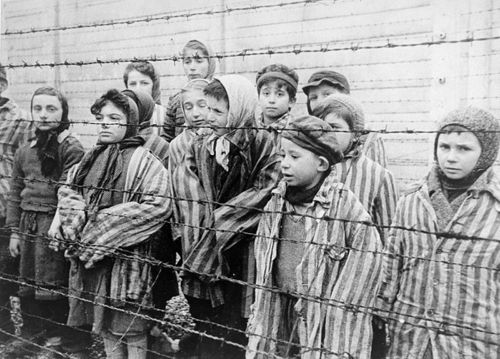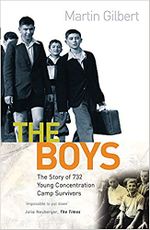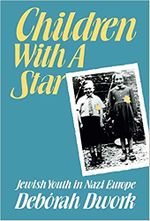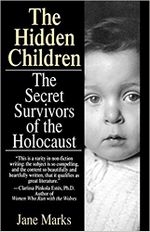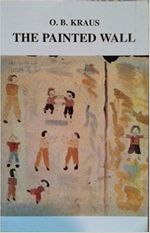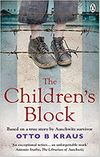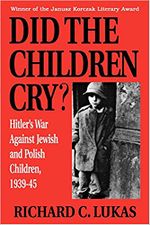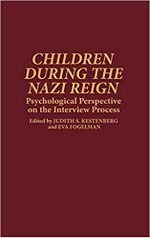Difference between revisions of "Category:Holocaust Children Studies--1990s"
(→1990) |
|||
| Line 149: | Line 149: | ||
[[Eva Fogelman]] was born in a displaced persons camp in Kassel, Germany after World War II. She lived in Israel for a brief period before coming to the United States in 1959, where she pursued her career as a psychologist. | [[Eva Fogelman]] was born in a displaced persons camp in Kassel, Germany after World War II. She lived in Israel for a brief period before coming to the United States in 1959, where she pursued her career as a psychologist. | ||
==== 1995 ==== | ==== 1995 ==== | ||
Revision as of 13:20, 23 February 2022
|
|
Holocaust Children Studies : 2020s -- 2010s -- 2000s -- 1990s -- 1980s -- 1970s -- 1960s -- 1950s -- 1940s -- 1930s -- Home General : 2020s -- 2010s -- 2000s -- 1990s -- 1980s -- 1970s -- 1960s -- 1950s -- 1940s -- 1930s -- 1920s -- 1910s -- 1900s -- 1850s -- 1800s -- 1700s -- 1600s -- 1500s -- 1450s -- Medieval -- Home
|
1991
Gerhard Durlacher. De zoektocht <Dutch> (Amsterdam : Meulenhoff, 1991).
English ed. The Search: The Birkenau Boys, trans. Susan Massotty (London ; New York : Serpent's Tail, 1998).
Also translated into German (Die Suche : Bericht über den Tod und das Uberleben, Hamburg: Europäische Verlagsanstalt, 1995).
"Gerhard Durlacher was stunned to discover that he was not the only survivor who was assigned to Auschwitz-Birkenau in 1944. The Search follows his quest to find his fellow survivors and ends with a reunion of the Birkenau boys in Israel in 1990 ... A child survivor of the Holocaust, Durlacher long believed that he was the only person still alive from a group of 89 boys assigned to the Birkenau extermination camp in 1944. After he learned that he was wrong, he set himself the task of confronting his past by locating some of the others. As in many other Holocaust memoirs, the prose here is spare, and the lack of detail can be a little confusing. For example, the reader is thrown into the author's search without a description of the process that led him to take his journey. But some psychological truisms emerge in this gray travelogue that, while not fresh, are worth ruminating over. What the author, a professor of sociology at the University of Amsterdam who died in 1996, finds is that even though the survivors shared a common experience, how they have coped with their wartime suffering differs. Some, in particular those who have moved to Israel, meet regularly with other survivors; others keep their harrowing past buried deep in their psyches. Equally diverse are survivors' personal outlooks--despite what they have gone through, some of the "Birkenau Boys" still call themselves optimists, while others possess the bitterness one would expect. Not surprisingly, Durlacher, who wrote two previous books on the Holocaust, enjoyed the company of the former much more than the latter."--Publisher description.
Gerhard Durlacher (1928-1996) was a Holocaust child survivor and writer.
1991
Martin Gilbert. The Boys: Triumph over Adversity (London: Weidenfeld & Nicolson, 1991).
"The story of 732 young concentration camp survivors ... In August 1945, Britain offered to take in 1,000 young survivors [of the Holocaust]. Only 732 could be found. Flown to England, they first settled in the Lake District. They formed a tightly knit group of friends whose terrible shared experience is almost beyond imagining. This is their story, which begins in the lost communities of pre-World War II central Europe, moves through ghetto, concentration camp and death march, to liberation, survival, and finally, fifty years later, a deeply moving reunion ... After sharing their annual reunions for twenty years with historian Martin Gilbert, the men and women of "The Boys" asked him to share their recollections and experiences ... The Boys bears witness to the human spirit, enduring the depths, and bearing hopefully the burden and challenge of survival."--Publisher description.
Martin Gilbert (1936-2015) was a British historian and honorary Fellow of Merton College, University of Oxford. He was the author of eighty-eight books, including works on Winston Churchill, the 20th century, and Jewish history including the Holocaust.
1991
Deborah Dwork. Children with a Star: Jewish Youth in Nazi Europe (New Haven, CT: Yale University Press, 1991).
Translated into German (1994), Italian (1994), Dutch (1998), and Japanese (1999).
"Based on many oral histories taken from child survivors of the Holocaust, the author focuses on the experiences of young Jewish children from their earliest encounters with anti-Semitism to their enslavement in labor camps ... Many books have been written about the experiences of Jews in Nazi Europe. None, however, has focused on the persecution of the most vulnerable members of the Jewish community―its children. This powerful and moving book by Deborah Dwork relates the history of these children for the first time ... The book is based on hundreds of oral histories conducted with survivors who were children in the Holocaust, in Europe and North America, an extraordinary range of primary documentation uncovered by the author (including diaries, letters, photographs and family albums), and archival records. Drawing on these sources, Dwork reveals the feelings, daily activities, and perceptions of Jewish children who lived and died in the shadow of the Holocaust. She reconstructs and analyzes the many different experiences the children faced. In the early years of Nazi domination they lived at home, increasingly opposed by rising anti-Semitism. Later some went into hiding while others attempted to live openly on gentile papers. As time passed, increasing numbers were forced into transit camps, ghettos, and death and slave labor camps. Although nearly ninety percent of the Jewish children in Nazi Europe were murdered, we learn in this history not of their deaths but of the circumstances of their lives ... Children with a Star is a major new contribution to the history of Europe during the Nazi era. It explains from a different perspective how European society functioned during the wary years, how the German noose tightened, and how the Jewish victims and their gentile neighbors responded. It expands the definition of resistance by examining the history of the people―primarily women―who helped Jewish children during the war. By focusing on children, it strips away rationalizations that the victims of Nazism somehow “allowed or “deserved” their punishment. And by examining the experience of children and thereby laying bare how society functions at its most fundamental level, it not only provides a unique understanding of the Holocaust but a new theoretical approach to the study of history."--Publisher description.
Deborah Dwork is Senior Research Scholar, Strassler Center for Holocaust and Genocide Studies and Department of History, Clark University, Worcester, MA. Dwork moved from the history of childhood as a social construct to the history of children as subjects and actors. Her historical analysis used children’s experiences as a lens through which to view all of society.
1993 (a)
Jane Marks. The Hidden Children: The Secret Survivors of the Holocaust (New York : Ballantine Books, 1993).
"They hid wherever they could for as long as it took the Allies to win the war -- Jewish children, frightened, alone, often separated from their families. For months, even years, they faced the constant danger of discovery, fabricating new identities at a young age, sacrificing their childhoods to save their lives. These secret survivors have suppressed these painful memories for decades. Now, in The Hidden Children, twenty-three adult survivors share their moving wartime experiences -- some for the first time ... There is Rosa, who hid in an impoverished one-room farmhouse with three others, sleeping on a clay pallet behind a stove; Renee, who posed as a Catholic and was kept in a convent by nuns who knew her secret; and Richard, who lived in a closet with his family for thirteen months. Their personal stories of belief and determination give a voice, at last, to the forgotten. Inspiring and life-affirming, The Hidden Children is an unparalleled document of witness, discovery, and the miracle of human courage."--Publisher description.
Jane Marks is an American author and journalist whose article in New York magazine became the basis for her book on children who survived the Holocaust in hiding.
1994 (a)
Ota B. Kraus. The Painted Wall / The Children's Block (Tel-Aviv : Yaron Golan Publ., 1994). Repr. London: Ebury Press, 2019. Also translated into German (2002).
A semi-fictional account, based on his own personal experience.
"In the novel The Painted Wall, Otto (Ota) B. Kraus writes about his own experience in Auschwitz during WWII. Otto was one of the instructors in the children's block and his (future) wife Dita, was the librarian for the children, of whom only a handfull survived. The book, which was originally named "The Diary", was written after the war. The story of a diary is but a literary introduction, yet the events described in the book are real. The Painted Wall tells the true story of 500 Jewish children who lived in the Czech Family Camp in Auschwitz-Birkenau between September 1943 and June 1944. The children were kept on a Children's Block supervised by the notorious Dr. Mengele, where their instructors organized clandestine lessons, singalongs and even staged little plays and charades. The Children's Block was intended to provide the Nazis with an alibi to refute the rumors of the Final Solution. As long as the Children's Block existed, it was a shelter and haven for the hundreds of children, who soon afterwards perished in the gas chambers."--Publisher description.
Ota "Otto" B. Kraus (1921-2000) was born and raised in Prague to a Jewish family. In May 1942 he was confined with his family to Ghetto Terezin . In December 1943 he was deported to Auschwitz, where at the time the Nazis had established a special family camps for those arriving from Terezin. Otto became one of the children’s counselors on the Kinderblock, a special barracks where the children were kept during the day. After a few months the camp was liquidated and the inmates were almost all sent to the gas chambers. Otto was one of the few selected to survive as labor force. A fervent Zionist, after the war he settled to Israel, where he was a teacher and writer.
1994 (b)
Richard C. Lukas. Did the Children Cry?: Hitler's War Against Jewish and Polish Children (New York, NY: Hippocrene Books, 1994).
"An unprecedented aspect of Nazi genocide in World War II was the cold and deliberate decision not to spare the children. Jewish children, first driven into the ghettos, were marked for total destruction as part of the "Final Solution" once it was put into effect, in 1942. Gentile children were starved, killed, or Germanized in order to reduce the Polish nation to a small complement of semi-literate slaves tending the Herrenvolk in their thousand-year Reich. This record also includes accounts of how they fought back by working for the underground, smuggling food into the ghettos, attending secret classes to continue their forbidden education. Included are stories of villains like Mengele who selected children for execution during Jewish religious holidays; Rudolph Hoess, Auschwitz's commandant who admitted his own discomfort when he witnessed the gassing of prisoners with the excuse: "I was a soldier and an officer"; a heroic Dr. Janusz Korczak who was in charge of an orphanage in the ghetto, but refused to leave his orphans, and at the head of a contingent of 192 children and 8 staff members, erect, his eyes looking into the distance, held the hands of two children as he led them to the railroad platform where trains took them to certain death. Based on vast research in the United States, Great Britain, and Poland, many interviews, theses and other papers, documents and official histories, memoirs, autobiographies, articles, periodicals and newspapers, Did the Children Cry? stands as a monument to millions of children who were bombed, wounded, deported, raped, starved, maimed, subjected to "medical" experimentation, and killed in German-occupied Poland."--Publisher description.
Richard C. Lukas (b.1937) is an American historian and author of books and articles on military, diplomatic, Polish, and Polish-American history. He specializes in the history of Poland during World War II.
1994 (c)
Judith S. Kestenberg, and Eva Fogelman, eds. Children During the Nazi Reign: Psychological Perspective on the Interview Process (Greenwood, 1994).
"This work shows how interviews help child survivors of the Jewish experience during World War II. It is unique in that it features different aspects of the interviewer-interviewee relationship. The contributions are personal as well as analytical in nature, and the narrative is an informed psychological analysis. The work should be of interest to Holocaust centers, researchers, oral historians, psychiatrists, psychologists, social workers, sociologists, and trauma researchers as well as survivors."--Publisher description.
Judith Ida Kestenberg (née Silberpfennig; 1910-1999) was a child psychiatrist who worked with Holocaust survivors. She founded the International Study of Organized Persecution of Children (ISOPC) an organization that coordinated the psychologically informed interviews of over 1500 child survivors throughout much of the world. Born in Poland to a Jewish family, she studied in Vienna. In 1937 she moved to the United States, where she spent her entire career.
Eva Fogelman was born in a displaced persons camp in Kassel, Germany after World War II. She lived in Israel for a brief period before coming to the United States in 1959, where she pursued her career as a psychologist.
1995
- Le mémorial des enfants juifs déportés de France (French children of the Holocaust / 1995, 1996
Subcategories
This category has only the following subcategory.
Media in category "Holocaust Children Studies--1990s"
The following 82 files are in this category, out of 82 total.
- 1990 Holland (film).jpg 332 × 475; 39 KB
- 1990 Lagnado.jpg 322 × 499; 38 KB
- 1990 Perel.jpg 324 × 499; 25 KB
- 1990 Wajda (film).jpg 208 × 300; 31 KB
- 1991 Brown.jpg 1,424 × 1,808; 525 KB
- 1991 Durlacher nl.jpg 120 × 200; 6 KB
- 1991 Dwork.jpg 339 × 499; 36 KB
- 1991 Gilbert.jpg 325 × 499; 31 KB
- 1991 Muller.jpg 351 × 499; 29 KB
- 1991 Urman.jpg 324 × 499; 27 KB
- 1992 Drucker.jpg 333 × 499; 38 KB
- 1992 Kertész.jpg 325 × 500; 33 KB
- 1992 Lindwer.jpg 318 × 499; 27 KB
- 1992 Van Wanegen film.png 252 × 396; 214 KB
- 1993 Faenza film.jpg 262 × 379; 23 KB
- 1993 Marks.jpg 322 × 499; 31 KB
- 1993 Matas.jpg 400 × 608; 81 KB
- 1993 Oberski it.jpg 201 × 339; 9 KB
- 1993 Pacifici.jpg 201 × 306; 6 KB
- 1993 Rubin.jpg 350 × 499; 24 KB
- 1993 Toll.jpg 322 × 499; 40 KB
- 1993 Valent.jpg 324 × 499; 30 KB
- 1994 Birenbaum en.jpg 333 × 499; 26 KB
- 1994 Kestenberg.jpg 314 × 499; 18 KB
- 1994 Kraus.jpg 321 × 499; 21 KB
- 1994 Levi.jpg 333 × 500; 30 KB
- 1994 Lukas.jpg 333 × 499; 40 KB
- 1994 Miller.jpg 339 × 499; 24 KB
- 1994 Rabinovici.jpg 327 × 499; 38 KB
- 1994 Rosenberg.jpg 310 × 474; 31 KB
- 1994 Stein.jpg 296 × 474; 23 KB
- 1994 Treves.jpg 201 × 293; 4 KB
- 1995 Akavia.jpg 318 × 499; 23 KB
- 1995 Blair doc.jpg 580 × 859; 100 KB
- 1995 Blend.jpg 400 × 625; 34 KB
- 1995 Boas.jpg 334 × 499; 30 KB
- 1995 Bricarelli.jpg 204 × 300; 5 KB
- 1995 Frank en.jpg 400 × 661; 218 KB
- 1995 Graver (book).jpg 400 × 630; 32 KB
- 1995 Lee.jpg 336 × 474; 19 KB
- 1995 Levi.jpg 187 × 266; 5 KB
- 1995 Machlin.jpg 310 × 475; 39 KB
- 1995 Nagaoka (film).jpg 267 × 372; 13 KB
- 1995 Pagnotti.jpg 327 × 499; 31 KB
- 1995 Starkopf.jpg 332 × 499; 22 KB
- 1995 Zargani.jpg 319 × 499; 27 KB
- 1996 Bennett (play).jpg 300 × 436; 52 KB
- 1996 David 2.jpg 177 × 250; 9 KB
- 1996 Hochberg - Grüss en.jpg 326 × 499; 39 KB
- 1996 Kestenberg.jpg 429 × 640; 77 KB
- 1996 Lazan.jpg 326 × 499; 23 KB
- 1996 Werber.jpg 308 × 499; 41 KB
- 1997 Bender (film).jpg 1,000 × 1,855; 156 KB
- 1997 Benigni (film).jpg 262 × 379; 28 KB
- 1997 Brenner.jpg 400 × 599; 126 KB
- 1997 Gold.jpg 400 × 586; 34 KB
- 1997 Kragh-Jacobsen film.jpg 1,000 × 1,400; 129 KB
- 1997 Maarsen en.jpg 1,920 × 2,560; 266 KB
- 1997 Melnick (book).jpg 400 × 648; 22 KB
- 1997 Minac (film).jpg 334 × 475; 26 KB
- 1997 Rimini.jpg 336 × 499; 17 KB
- 1997b Bitton-Jackson.jpg 298 × 500; 40 KB
- 1997b Winter.jpg 311 × 499; 24 KB
- 1998 Durlacher en.jpg 292 × 499; 26 KB
- 1998 Immell (ed).jpg 312 × 500; 33 KB
- 1998 Kestenberg.jpg 314 × 499; 19 KB
- 1998 Muller de.jpg 312 × 500; 29 KB
- 1998 Müller (book).jpg 334 × 499; 24 KB
- 1998 Müller en (book).jpg 400 × 606; 30 KB
- 1998 Nieuwsma.jpg 375 × 499; 28 KB
- 1998 Rabinovici en.jpg 323 × 499; 37 KB
- 1998 Rittner (ed).jpg 346 × 499; 15 KB
- 1999 Bloom (ed).jpg 226 × 350; 14 KB
- 1999 Fleischmann.jpg 338 × 499; 15 KB
- 1999 Fox.jpg 410 × 500; 36 KB
- 1999 Harris.jpg 324 × 499; 21 KB
- 1999 Justman (doc).jpg 1,000 × 1,333; 129 KB
- 1999 Kertész it.jpg 324 × 499; 25 KB
- 1999 Kustanowitz.jpg 371 × 499; 24 KB
- 1999 Minsky.jpg 332 × 499; 30 KB
- 1999 Segre (book).jpg 699 × 1,174; 149 KB
- 1999 Varon.jpg 328 × 499; 20 KB
